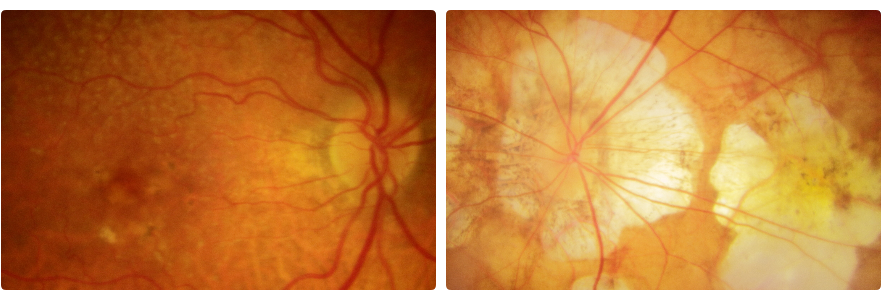AMD – Age-related Macular Degeneration
AMD – Age-related Macular Degeneration – is the leading cause of severe vision loss in people over age 60. It occurs when the small central portion of the retina, known as the macula, deteriorates. Because the disease develops as a person ages, it is often referred to as age-related macular degeneration (AMD). Although macular degeneration is almost never a totally blinding condition, it can be a source of significant visual disability. Besides for aging process other the risk factors are: atherosclerosis, hyperopia, smoking, sunlight exposure (UVA, UVB). Women and people with blue iris coloration are more predisposed to have AMD. In its early stages, macular degeneration may not have any symptoms and may be unrecognized until it progresses or affects both eyes. The first symptom of macular degeneration is usually a dim, blurry spot in the center of your vision. With the progression of the disease the central grey/black spot may get bigger or darker over time. Diminished or changed color perception may be noticed. If you experience any of these symptoms, see an eye doctor as soon as possible.
Most patients with macular degeneration have the dry form of the disease and can lose some form of central vision. However, the dry form of macular degeneration in about 10% can progress to the wet form.
There are two main types of age-related macular degeneration:
- Dry form. The “dry” form of macular degeneration is characterized by the presence of yellow deposits, called drusen, in the macula. A few small drusen may not cause changes in vision; however, as they grow in size and increase in number, they may lead to a dimming or distortion of vision that people find most noticeable when they read. In more advanced stages of dry macular degeneration, there is also a thinning of the light-sensitive layer of cells in the macula leading to atrophy, or tissue death. In the atrophic form of dry macular degeneration, patients may have blind spots in the center of their vision. In the advanced stages, patients lose central vision.
- Wet form. The exudative or “wet” form of macular degeneration is characterized by the growth of abnormal blood vessels from the choroid underneath the macula. This is called choroidal neovascularization. These blood vessels leak blood and fluid into the retina, causing distortion of vision that makes straight lines look wavy, as well as blind spots and loss of central vision. These abnormal blood vessels eventually scar, leading to permanent loss of central vision.




